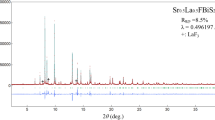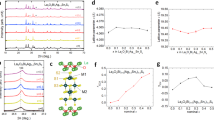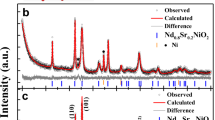Abstract
The Matthias rule, which is an empirical correlation between the superconducting transition temperature (Tc) and the average number of valence electrons per atom (n) in alloys and intermetallic compounds, has been used in the past as a guiding principle to search for new superconductors with higher Tc. The intermetallic compound SrBi3 (AuCu3 structure) exhibits a Tc of 5.6 K. An ab-initio electronic band structure calculation for SrBi3 predicted that Tc increases on decreasing the Fermi energy, i.e., on decreasing n, because of a steep increase in the density of states. In this study, we demonstrated that high-pressure (~ 3 GPa) and low-temperature ( < 350 °C) synthesis conditions enables the substitution of Na for about 40 at.% of Sr. With a consequent decrease in n, the Tc of (Sr,Na)Bi3 increases to 9.0 K. A new high-Tc peak is observed in the oscillatory dependence of Tc on n in compounds with the AuCu3 structure. We have shown that the oscillatory dependence of Tc is in good agreement with the band structure calculation. Our experiments reaffirm the importance of controlling the number of electrons in intermetallic compounds.
Similar content being viewed by others
Introduction
In various transition metals, their alloys and intermetallic compounds, an empirical correlation exists between Tc and the average number of valence electrons (electrons outside of closed shells) per atom, n. The n is simply calculated from a chemical formula. For example, the total valence electrons in Nb3Ge are 19 because Nb and Ge atoms have 5 and 4 electrons outside of closed shells, respectively. Therefore, the n is calculated to be 4.75 by dividing 19 by 4 (the number of atoms in the formula). The most notable examples are 4d transition metal alloys and the A15 (Cr3Si structure) compounds1,2,3, among which materials with n = 4.7 or 6.7 tend to exhibit high Tc. For Nb3Ge, the material with the highest Tc (=23.9 K) among the A15 compounds4, n = 4.75. It is argued that this empirical rule, called the Matthias rule, is associated with the characteristic shape of the density of states N(E), which exhibits sharp peaks corresponding to these electron numbers5,6.
In principle, the above empirical rule should hold for various types of superconductors. Therefore, the Tc of superconductors with given crystal/electronic structures can theoretically be increased by tuning the electron number n so as to maximize N(E) at the Fermi energy E F. In this study, we demonstrated that this guiding principle holds for a real material, SrBi3 (Tc = 5.62 K7). This intermetallic compound is crystallized into an AuCu3 structure as shown in Fig. 1. According to an ab-initio electronic band structure calculation, the N(E) around EF of SrBi3 is dominated by the Bi 6p orbitals (Fig. 1). A sharp peak in N(E) is located 0.02 Ry below EF , as indicated by an arrow in Fig. 1. Assuming a rigid band model, one expects that Tc would be increased on decreasing EF , which is realized by decreasing n.
The most straightforward way to decrease n in SrBi3 is to replace divalent Sr ions with monovalent alkali metal ions, such as K or Na. However, to our knowledge, such substitution has not successfully been performed in usual intermetallic compounds, because alkali metals are far more reactive compared to alkaline earth metals. The synthesis conditions of the substituted samples are thus entirely different from those of the pristine ones; in particular, the substituted samples require low-temperature and tightly sealed conditions in order to prevent the evaporation of volatile alkali metals. We realized such conditions by using a cubic-anvil-type high-pressure (HP) apparatus and succeeded in synthesizing (Sr,Na)Bi3. As expected, the Tc of (Sr,Na)Bi3 increases with Na concentration, reaching up to 9.0 K. Based on the present results, we demonstrated that there is a new and higher peak in the oscillatory relationship between Tc and n for materials with an AuCu3 structure and that the relationship results from the n-dependence of N(E), which is characteristic of this crystal structure.
Results
Introduction of Na and enhancement in Tc through the high-pressure, low-temperature synthesis
Figure 2 shows the χ(T) of the samples with nominal compositions of (Sr1-xNa1.5x)Bi3 (x = 0.5) synthesized under various temperatures (Tsyn) ranging from 300–450 °C for 6 h. For the case of Tsyn = 350 and 300 °C, samples were slowly cooled (20 °C/h) to 225 and 200 °C, respectively. All the samples exhibit higher Tc compared to pristine SrBi3 (Tc = 5.6 K). Moreover, Tc increases on lowering Tsyn, up to 9.0 K (indicated by an arrow) for Tsyn = 300 °C. The Tc of 9.0 K is the second highest among the superconductors possessing the AuCu3 structure, the highest being Tc = 9.54 K for InLa38.
Temperature (T) dependence of normalized field-cooled (FC) susceptibilities χ(T) for samples with nominal compositions of (Sr1-xNa1.5x)Bi3 (x = 0.5) synthesized at various temperatures (Tsyn). χ(T) is normalized between 5 and 10 K for clarity. As Tsyn decreases, Tc increases, reaching up to 9.0 K, as indicated by an arrow.
The lattice parameter of the samples, a, decreases with decreasing Tsyn; for example, a = 5.013, 4.992 and 4.989 Å for Tsyn = 450, 400 and 300 °C, respectively. (a = 5.04 Å for SrBi3). The decrease in the lattice parameter is due to the increase in Na substitution at the Sr sites, as will be elaborated in a later section.
It should be noted that HP, low-temperature synthesis conditions promote the Na substitution for Sr. Indeed, the sample synthesized under ambient conditions (x = 0.5, annealed at 300 °C in an evacuated quartz tube) exhibits a lower Tc of 6.5 K and larger a of 5.033 Å.
Change in the structure upon Na substitution: powder X-ray diffraction patterns
As the next step, we synthesized series of samples with various values of x – 0, 0.2, 0.4, 0.5 and 0.6 – by reacting the starting materials at 350 °C for 6 h, following which annealing was performed at (or with slow cooling down to) 275–225 °C for 6 h at a pressure of 3.4 GPa.
The powder XRD patterns of the reacted samples are shown in Fig. 3. Major peaks can be indexed on the basis of the cubic unit cell expected for the AuCu3 structure. The a value of SrBi3 (x = 0) calculated using a least-squares fitting is 5.043 Å, which is in good agreement with the previously reported value (5.035–5.04 Å)9. The overall X-ray patterns do not change with increase in x, while the peak width broadens, which is due to the disorder associated with the Na substitution at the Sr sites. Diffraction peaks corresponding to Bi are observed for all samples, with their intensity increasing with x. For the samples with x = 0.5 and 0.6, peaks corresponding to NaBi are also observed, indicating that the introduced Na is not completely incorporated into the samples and that the solubility limit is around x = 0.4–0.5.
The x-dependence of lattice parameter a and Tc
Figure 4(a) shows χ(T) for the samples with various values of x. SrBi3 (x = 0) shows a sharp superconducting transition at 5.6 K, which is in good agreement with the reported value. As x increases, Tc monotonously shifts to higher temperatures. Note that the transition width does not change with changing x, suggesting that Na is uniformly incorporated into the samples. The shielding volume fraction calculated from the ZFC susceptibility value at 5 K exceeded 100% for all samples, indicating bulk superconductivity.
In Fig. 4(b), the lattice parameter a and Tc are plotted as functions of x. The lattice parameter a decreases linearly with x up to x = 0.3 and then saturates above x = 0.4. The decrease of a results from the substitution of smaller Na+ (with ionic radius (XII coordination) of 1.39 Å10) into the Sr2+ (1.44 Å) sites. The substitution of larger K+ (ionic radius of 1.64 Å) into the Sr2+ sites was not successful. As seen in Fig. 4(b), Tc and a exhibit similar x-dependences; they change linearly with x up to x = 0.3 and then saturate in the vicinity of x = 0.4. These behaviours again indicate that the Na solubility limit is around x = 0.4.
Discussion
In the present study, we demonstrated that the Tc of SrBi3 increases with decreasing n. The relationship between Tc and n for compounds with the AuCu3 structure was first discussed by Havinga et al.9. They showed that Tc exhibits an oscillatory dependence on n with peaks at n = 3.75 and 4.00. For example, LaSn3 (Tc = 6.02 K) and ThPb3 (Tc = 5.55 K) have n = 3.75 and 4.00, respectively. Most known superconductors with the AuCu3 structure have n values in the range 2.75 ≤ n ≤ 4.00. SrBi3 (n = 4.25) has an exceptionally large n, which enabled us to investigate Tc for 4.00 ≤ n ≤ 4.25.
Figure 5 shows the general relationship between n and Tc for superconductors with the AuCu3 structure that contain Pb, Bi, or Tl at the crystallographic Cu site. Their band structures near EF are similar; the band structures are dominated by Bi (or Pb, Tl) 6p orbitals, as shown in Fig. 1. In Fig. 5, one can recognize a clear oscillation of Tc with respect to n. In particular, a new Tc peak corresponding to (Sr,Na)Bi3 is observed at n ~ 4.15. This peak is higher than those located around n = 3.25 and 3.70. These Tc peaks reflect the shape of N(E) shown in Fig. 1. In Fig. 1, the N(E) peak immediately below EF corresponds to n = 4.0 and the next two N(E) peaks at energies of ~ 0.41 Ry and ~ 0.38 Ry correspond to n ~ 3.5 and n ~ 3.25, respectively. These peaks are mainly attributed to the Bi-6pπ-bonding bands, which have narrow band widths. Considering the crudeness of the rigid band model, the agreement between the experiments and theory is reasonably good.
Relationship between n and Tc of superconductors with the AuCu3 structure that contain Pb, Bi, or Tl at the Cu site. Data of the present study are added to those taken from Havinga et al9.
In summary, we have demonstrated that the Tc of SrBi3 increases by tuning the number of valence electrons on the basis of the prediction from the band structure calculation. High-pressure and low-temperature synthesis conditions enables to substitute a large amount of Na for Sr in SrBi3. Consequently, the Tc of SrBi3 increases from 5.6 K to as high as 9.0 K by decreasing the n. We have shown that a new high oscillation peak appears on the n dependence of Tc in compounds with the AuCu3 structure and the Tc oscillation is in good agreement with the band structure.
Methods
Electronic band structure calculation
Our calculation is based on the local-density approximation (LDA) and implemented using the computer code KANSAI-94 and TSPACE11. Spin-orbit interaction is included in a second-variational procedure. We used the experimental value of 5.043 Å for the lattice parameter a. The muffin-tin radii were set as 0.252a for Sr and 0.231a for Bi.
Preparation of (Sr,Na)Bi3 samples
Series of polycrystalline samples of (Sr,Na)Bi3 were synthesized through a solid-state reaction by using a cubic-anvil-type HP apparatus. The starting materials were Bi, Na3Bi and Sr5Bi3 powders. Na3Bi powder was prepared by heating an appropriate amount of Na and Bi chunks at 900 °C in an alumina crucible sealed in a stainless-steel vessel12. Sr5Bi3 was prepared by heating a mixture of Bi and Sr powders to 950 °C by using the HP synthesis method or a method similar to that used for preparing Na3Bi powder.
An appropriate amount of the starting materials were ground with agate mortar in a nitrogen-filled glove box and pressed into a pellet. Excess Na (50%) was added to the starting compositions to compensate for possible Na loss during the heat treatment. The pellet with a nominal composition of (Sr1-xNa1.5x)Bi3 was placed in a BN crucible and assembled into an HP cell13. The sample was heated under a pressure of 3.4 GPa. As we have described, the Tc of samples strongly depends on the sample synthesis temperature (Tsyn); Tc monotonously increases with decreasing Tsyn, even when starting from the same nominal values of x. The resulting samples were handled in a nitrogen- or argon-filled glove box because of their reactivity in air.
Material characterization
Powder X-ray diffraction (XRD) patterns were measured at room temperature using Cu Kα radiation. Because the samples are easily degraded by reactions with oxygen and/or moisture in air, a polyimide adhesive tape was placed on the sample and the XRD pattern was collected for 8 min using a diffractometer equipped with a high-speed detector system (Rigaku, D/teX Ultra). Temperature (T)-dependent magnetic susceptibility (χ(T)) measurement was performed using a magnetic property measurement system (MPMS) (Quantum Design, MPMS-XL7) under a magnetic field of 0.001 T. The data were collected during warming after zero-field cooling (ZFC) and then during field cooling (FC). T-dependent electrical resistivity (ρ(T)) was measured using the four-probe method under magnetic fields of up to 2.4 T. Because the sample is unstable in air, the electrodes were coated with a silver paste in an argon-filled glove box and covered with APIEZON grease before exposure to air.
Additional Information
How to cite this article: Iyo, A. et al. Large enhancement of superconducting transition temperature of SrBi3 induced by Na substitution for Sr. Sci. Rep. 5, 10089; doi: 10.1038/srep10089 (2015).
References
Matthias, B. T. Empirical relation between superconductivity and the number of valence electrons per atom. Phys. Rev. 97, 74–76 (1955).
Johnson, W. L. Superconductivity and electronic properties of amorphous transition metal alloys. J. Appl. Phys. 50, 1557–1563 (1979).
Matthias, B. T. Wood, E. A. Corenzwit, E. & Bala, V. B. Superconductivity and electron concentration. J. Phys. Chem. Solids 1, 188–190 (1956).
Gomersall, I. R. & Gyorffy, B. L. 14th International Conference on Low Temperature Physics [ Krusius, M. & Vuoris, M. (ed.)] 5, 449 (North-Holland/American Elsevier, 1975).
Mattheiss, L. F. Electronic structure of niobium and tantalum. Phys. Rev. B. 1, 373–374 (1970).
Klein, B. M. Boyer, L. L. Papaconstantopoulos, D. A. & Mattheiss, L. F. Self-consistent augmented-plane-wave electronic-structure calculations for the A15 compounds V3X and Nb3X, X = Al, Ga, Si, Ge and Sn. Phys. Rev. B. 18, 6411–6438 (1978).
Matthias, B. T. & Hulm, J. K. A search for new superconducting compounds. Phys. Rev. B. 87, 799–806 (1952).
Heiniger, F. Bucher, E. Maita, J. P. & Descouts, P. Superconducting and other electronic properties of La3In, La3Tl and some related phases. Phys. Rev. B. 8, 3194–3205 (1973).
Havinga, E. E. Damsma, H. & Van Maaren, M. H. Oscillatory dependence of superconductive critical temperature on number of valency electrons in Cu3Au-type alloys. J. Phys. Chem. Solid 31, 2653–2662 (1970).
Shannon, R. D. Revised effective ionic radii and systematic studies of interatomic distances in halides and chalcogenides. Acta Cryst. A. 32, 751–767 (1976).
A. Yanase, Fortran Program For Space Group (TSPACE) (in Japanese) Shokabo, Tokyo (1995).
Kihou, K. et al. Single crystal growth and characterization of the iron-based superconductor KFe2As2 synthesized by KAs flux method. J. Phys. Soc. Jpn. 79, 124713-1-124713-5 (2010).
Shirage, P. M. et al., High-pressure synthesis and physical properties of new iron (nickel)-based superconductors. Physica C. 469, 355–369 (2009).
Acknowledgements
This work was partially supported by the Strategic International Collaborative Research Program (SICORP) of the Japan Science and Technology Agency (JST) and KAKENHI (Grant No. 26400379) from the Japan Society for the Promotion of Science (JSPS).
Author information
Authors and Affiliations
Contributions
A. I., Y. Y., T. K., S. I., H. K. and K. O. performed the sample preparation and characterization. A. I., T. N., Y. Y. and H. E. drafted the manuscript. T. K., T. N. and N. T measured superconducting properties of samples. I. H. and T. Y. performed an ab-initio electronic band structure calculation. All authors reviewed and approved the manuscript.
Ethics declarations
Competing interests
The authors declare no competing financial interests.
Rights and permissions
This work is licensed under a Creative Commons Attribution 4.0 International License. The images or other third party material in this article are included in the article’s Creative Commons license, unless indicated otherwise in the credit line; if the material is not included under the Creative Commons license, users will need to obtain permission from the license holder to reproduce the material. To view a copy of this license, visit http://creativecommons.org/licenses/by/4.0/
About this article
Cite this article
Iyo, A., Yanagi, Y., Kinjo, T. et al. Large enhancement of superconducting transition temperature of SrBi3 induced by Na substitution for Sr. Sci Rep 5, 10089 (2015). https://doi.org/10.1038/srep10089
Received:
Accepted:
Published:
DOI: https://doi.org/10.1038/srep10089
This article is cited by
-
Structural and electronic properties of amorphous bismuth calcium borate from first-principle calculations
Structural Chemistry (2021)
-
Paramagnetic Meissner Effect Observed in SrBi3 with κ Close to the Critical Regime
Journal of Superconductivity and Novel Magnetism (2020)
-
Spin-orbit coupling enhanced superconductivity in Bi-rich compounds ABi3 (A = Sr and Ba)
Scientific Reports (2016)
Comments
By submitting a comment you agree to abide by our Terms and Community Guidelines. If you find something abusive or that does not comply with our terms or guidelines please flag it as inappropriate.








